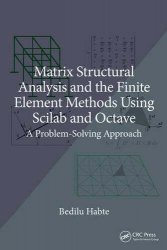 Название: Matrix Structural Analysis and the Finite Element Methods Using Scilab and Octave: A Problem-Solving Approach Название: Matrix Structural Analysis and the Finite Element Methods Using Scilab and Octave: A Problem-Solving Approach
Автор: Bedilu Habte
Издательство: CRC Press
Год: 2025
Страниц: 507
Язык: английский
Формат: pdf (true)
Размер: 10.1 MB
This book covers code development for structural analysis and includes topics from finite element methods such as modeling and analysis of continuum structures. It explains the concepts showing derivation of necessary equations, relationships, and steps in solving structural analysis problems. It contains worked examples, problem sets, and ample Scilab and Octave codes to teach structural analysis techniques using these softwares.
Access to computing facilities has been increasing from time to time, and a typical college student nowadays owns a laptop or has access to a personal computer at home or the college. Besides, there are appropriate software that assist in performing routine and complex matrix operations like matrix multiplication and inversion. The second reason for writing this book is to overcome those difficulties associated with formulating and solving structural analysis problems through programming or coding on a suitable platform step by step and interactively.
The book aims to provide concise reading materials explaining the concepts and showing the derivation of necessary equations, relationships and steps in solving structural analysis problems. It also contains worked examples, problem sets and ample Scilab and Octave code to teach structural analysis techniques using MSA/FEM. Scilab and Octave are free and open-source software for scientific computation and visualization. In addition to being free and open-source, they offer excellent platforms for practicing computer-aided structural analysis tasks. Since the syntax for Octave is identical to Matlab, the Octave program codes in this book can be executed in Matlab directly without any modification.
Scilab is a free software for scientific computation and visualization. It provides a command-line interface for user communication and contains a programming environment and a set of tools that will expand its functionality. It can be downloaded from the Scilab website; furthermore, an installation guide and getting-started tutorials are available there. Octave, also known as GNU Octave, is a high-level programming language primarily intended for numerical computations. It is used for solving linear and nonlinear equations, numerical linear algebra, statistical analysis and for performing other numerical experiments. It is open-source and available for any operating system.
Programming is preparing a series of computer code (statements) to accomplish a specific task. Both Scilab and Octave environments have many similar programming features. The program code is written using the code editor and will be saved in a file. Commonly, filenames with a file extension of .sci or .sce are associated with Scilab as program files, while in Octave the file extension .m is used. After that the code in the file is executed within the Scilab or Octave environment, respectively. Unlike some other programming languages, no code compilation process is needed. If there’s any syntax error (mistakes in the code), the program execution stops after displaying the specific error message; otherwise, the program runs and finishes executing all the statements sequentially.
Features:
Enables readers to distinguish between the flexibility and the stiffness methods of structural analysis.
Clarifies the procedures in the direct stiffness methods as applied to discrete structures and use of these for the analysis of 2D and 3D structures.
Presents treatment of Finite Element Methods as a logical extension of the Direct Stiffness Method.
Provides sufficient solved examples and didactic problems (with solutions) focusing on the analysis of statically indeterminate structures.
Treats discrete and continuum structural analysis using similar matrix analysis procedures.
Focused on problem solving through programming, this book guides senior undergraduate and graduate students in structural and civil engineering.
Contents:
Section I Matrix Structural Analysis. 1. Introduction. 2. The Basic Methods. 3. The Formalized Methods. 4. The Direct Stiffness Method. 5. Special Cases in the Direct Stiffness Method. Section II Finite Element Methods. 6. Introduction and 1D Finite Element Analysis. 7. 2D Finite Element Analysis. 8. 3D Finite Element Analysis.
Скачать Matrix Structural Analysis and the Finite Element Methods Using Scilab and Octave
|